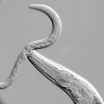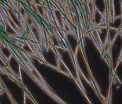(Press-News.org) This press release is available in German.
Researchers in the group of Ralf Sommer at the Max Planck Institute for Developmental Biology in Tuebingen, Germany, have for the first time been able to identify neuronal correlates of behaviour by comparing maps of synaptic connectivity, or "connectomes", between two species with different behaviour. They compared the pharyngeal nervous systems of two nematodes, the bacterial feeding Caenorhabditis elegans and the predator/omnivore Pristionchus pacificus and found large differences in how the neurons are "wired" together.
A long standing question in neurobiology is how certain behaviours are reflected in the pattern of connections between neurons. Answering this question requires a comparative approach, which has proved impossible even in a rather small organism like the nematode due to technical limitations in the preparation and analysis of the extremely large data sets. Dan Bumbarger and his colleagues have chosen the pharyngeal nervous systems of C. elegans and P. pacificus, which consist of only 20 neurons and show a high degree of independence from the body nervous system. These 20 neurons regulate the contraction of the pharynx muscles which are responsible for the uptake of food and its processing prior to digestion in the intestine.
Bumbarger has prepared ultra-thin sections of two Pristionchus worms and compared the number and location of synapses in the pharynx nervous system with the existing C. elegans data. Despite the small size of a nematode, data generation and analysis took over three years: Each of the 150 micrometre long pharynx regions yielded more than 3000 sections that had to be individually imaged and analysed under the electron microscope.
The first result of this extensive study came as a surprise: "By means of their shape and position each of the 20 neurons in Pristionchus pacificus could be correlated to an exact equivalent in Caenorhabditis elegans" explains the scientist. "This is all the more astonishing as the evolutionary distance between the two worm species is over 200 million years and they differ markedly in feeding behaviour and in the anatomy of their mouth parts." While C. elegans feeds exclusively on bacteria, P. pacificus is able to switch its behaviour to prey on other worms if bacterial food gets scarce.
These differences are reflected in the number and position of neuronal synapses. While in C. elegans only 9 out of 20 nerve cells are motor neurons, which primarily activate muscle cells, the number is up to 19 in P. pacificus; only one neuron functions exclusively as an interneuron, establishing connections between nerve cells. "This hints at substantial differences in information flow", states Ralf Sommer. Clearly, the regulation of movements is much more complex in P. pacificus – a finding which correlates perfectly with the predatory feeding behaviour of the worm.
By means of partly newly developed analytical methods the scientists in Tuebingen also compared the relevance of individual neurons and synapses for the entire network. It became obvious that two neurons in the anterior part of the P. pacificus pharynx have significantly gained in importance: They are the motor neurons regulating the muscle cells that control the movement of mouth parts, most prominently the movement of teeth which are not found in C. elegans. "The mouth parts are particularly active during a predatory attack, but not when feeding on bacteria" explains Sommer. In C. elegans, these two neurons function exclusively as interneurons. There are marked differences in the posterior part of the pharynx as well. This is where C. elegans has a specialized muscular "grinder" for crushing bacteria, their only food source. In P. Pacificus, which does not have a grinder, some of the muscle cells have lost synaptic connections with neurons.
"The patterns of synaptic connections perfectly mirror the fundamental differences in the feeding behaviours of P. pacificus and C. elegans", Ralf Sommer concludes. A clear-cut result like that was not what he had necessarily expected. Previous studies in much simpler neural circuits - as in the marine snail Aplysia – had indicated that changes in behaviour do not have to coincide with changes in number and location of synapses. Differences in physiological properties of neurons or in their modulation by neurotransmitters can be sufficient to effect behavioural changes.
INFORMATION:
Original publication:
Bumbarger et al.
System-Wide Rewiring Underlies Behavioral Differences in Predatory and Bacterial Feeding Nematodes.
Cell (2013), 17 January 2013
The neurobiological consequence of predating or grazing
Scientists from Tuebingen compare neuronal network connections in 2 worm species
2013-01-17
ELSE PRESS RELEASES FROM THIS DATE:
Study offers new insights into the mechanics of muscle fatigue
2013-01-17
A study in The Journal of General Physiology examines the consequences of muscle activity with surprising results, indicating that the extracellular accumulation of potassium that occurs in working muscles is considerably higher than previously thought.
Muscle excitation involves the influx of sodium ions and efflux of potassium ions. Although the fraction of ions that cross the muscle membrane with each contraction is minute, repeated activity can lead to substantial changes in the intracellular and extracellular concentrations of sodium and potassium ions. The extent ...
Pediatric coding top tips and pediatric CPT changes 2013
2013-01-17
Cyanobacteria belong to the Earth's oldest organisms. They are still present today in oceans and waters and even in hot springs. By producing oxygen and evolving into multicellular forms, they played a key role in the emergence of organisms that breathe oxygen. This has, now, been demonstrated by a team of scientists under the supervision and instruction of evolutionary biologists from the University of Zurich. According to their studies, cyanobacteria developed multicellularity around one billion years earlier than eukaryotes – cells with one true nucleus. At almost the ...
People with low risk for cocaine dependence have differently shaped brain to those with addiction
2013-01-17
People who take cocaine over many years without becoming addicted have a brain structure which is significantly different from those individuals who developed cocaine-dependence, researchers have discovered. New research from the University of Cambridge has found that recreational drug users who have not developed a dependence have an abnormally large frontal lobe, the section of the brain implicated in self-control. Their research was published in the journal Biological Psychiatry.
For the study, led by Dr Karen Ersche, individuals who use cocaine on a regular basis underwent ...
Cheating to create the perfect simulation
2013-01-17
(Jena) The planet Earth will die – if not before, then when the Sun collapses. This is going to happen in approximately seven billion years. In the universe however the death of suns and planets is an everyday occurance and our solar system partly consists of their remnants.
The end of stars – suns – rich in mass is often a neutron star. These "stars' liches" demonstrate a high density, in which atoms are extremely compressed. Such neutron stars are no bigger than a small town, but heavier than our sun, as physicist PD Dr. Axel Maas of the Jena University (Germany) points ...
Dietary shifts driving up phosphorus use
2013-01-17
Dietary changes since the early 1960s have fueled a sharp increase in the amount of mined phosphorus used to produce the food consumed by the average person over the course of a year, according to a new study led by researchers at McGill University.
Between 1961 and 2007, rising meat consumption and total calorie intake underpinned a 38% increase in the world's per capita "phosphorus footprint," the researchers conclude in a paper published online in Environmental Research Letters.
The findings underscore a significant challenge to efforts to sustainably manage the ...
Viagra converts fat cells
2013-01-17
Researchers from the University of Bonn treated mice with Viagra and made an amazing discovery: The drug converts undesirable white fat cells and could thus potentially melt the unwelcome "spare tire" around the midriff. In addition, the substance also decreases the risk of other complications caused by obesity. The results are now published in "The Journal of the Federation of American Societies for Experimental Biology" (FASEB).
Sildenafil – better known as Viagra – is used to treat erectile dysfunction. This substance prevents degradation of cyclic guanosine mono-phosphate ...
Is athleticism linked to brain size?
2013-01-17
VIDEO:
This movie shows running mice (bred-for-athleticism mouse on the left, regular mouse on the right).
Click here for more information.
RIVERSIDE, Calif. — Is athleticism linked to brain size? To find out, researchers at the University of California, Riverside performed laboratory experiments on house mice and found that mice that have been bred for dozens of generations to be more exercise-loving have larger midbrains than those that have not been selectively bred ...
Fighting sleep: UGA discovery may lead to new treatments for deadly sleeping sickness
2013-01-17
Athens, Ga. – While its common name may make it sound almost whimsical, sleeping sickness, or African trypanosomiasis, is in reality a potentially fatal parasitic infection that has ravaged populations in sub-Saharan Africa for decades, and it continues to infect thousands of people every year.
Few drugs have been developed to treat sleeping sickness since the 1940s, and those still in use are highly toxic, sometimes causing painful side effects and even death. But researchers at the University of Georgia have made a discovery that may soon lead to new therapies for this ...
Critically ill flu patients saved with artificial lung technology treatment
2013-01-17
TORONTO (January 17, 2013 ) - In recent weeks the intensive critical care units at University Health Network's Toronto General Hospital have used Extra Corporeal Lung Support (ECLS) to support five influenza (flu) patients in their recovery from severe respiratory problems.
ECLS systems are normally used at the hospital as a bridge to lung transplantation but increasingly, the hospital is using ECLS on patients where the usual breathing machines (ventilators) cannot support the patient whose lungs need time to rest and heal.
The ECLS systems are essentially artificial ...
Drug abuse impairs sexual performance in men even after rehabilitation
2013-01-17
Researchers at the University of Granada, Spain, and Santo Tomas University in Colombia have found that drug abuse negatively affects sexual performance in men even after years of abstinence. This finding contradicts other studies reporting that men spontaneously recovered their normal sexual performance at three weeks after quitting substance abuse.
The results of this study have been published in the prestigious Journal of Sexual Medicine, the official journal of the International Society for Sexual Medicine. The authors of this paper are Pablo Vallejo Medina –a professor ...
LAST 30 PRESS RELEASES:
AI overestimates how smart people are, according to HSE economists
HSE researchers create genome-wide map of quadruplexes
Scientists boost cell "powerhouses" to burn more calories
Automatic label checking: The missing step in making reliable medical AI
Low daily alcohol intake linked to 50% heightened mouth cancer risk in India
American Meteorological Society announces Rick Spinrad as 2026 President-Elect
Biomass-based carbon capture spotlighted in newly released global climate webinar recording
Illuminating invisible nano pollutants: advanced bioimaging tracks the full journey of emerging nanoscale contaminants in living systems
How does age affect recovery from spinal cord injury?
Novel AI tool offers prognosis for patients with head and neck cancer
Fathers’ microplastic exposure tied to their children’s metabolic problems
Research validates laboratory model for studying high-grade serous ovarian cancer
SIR 2026 delivers transformative breakthroughs in minimally invasive medicine to improve patient care
Stem Cell Reports most downloaded papers of 2025 highlight the breadth and impact of stem cell research
Oxford-led study estimates NHS spends around 3% of its primary and secondary care budget on the health impacts of heat and cold in England
A researcher’s long quest leads to a smart composite breakthrough
Urban wild bees act as “microbial sensors” of city health.
New study finds where you live affects recovery after a hip fracture
Forecasting the impact of fully automated vehicle adoption on US road traffic injuries
Alcohol-related hospitalizations from 2016 to 2022
Semaglutide and hospitalizations in patients with obesity and established cardiovascular disease
Researchers ‘listen in’ to embryo-mother interactions during implantation using a culture system replicating the womb lining
How changing your diet could help save the world
How to make AI truly scalable and reliable for real-time traffic assignment?
Beyond fragmented markets: A new framework for efficient and stable ride-pooling
Can shape priors make road perception more reliable for autonomous driving?
AI tracks nearly 100 years of aging research, revealing key trends and gaps
Innovative techniques enable Italy’s first imaging of individual trapped atoms
KIER successfully develops Korea-made “calibration thermoelectric module” for measuring thermoelectric device performance
Diversifying US Midwest farming for stability and resilience
[Press-News.org] The neurobiological consequence of predating or grazingScientists from Tuebingen compare neuronal network connections in 2 worm species



